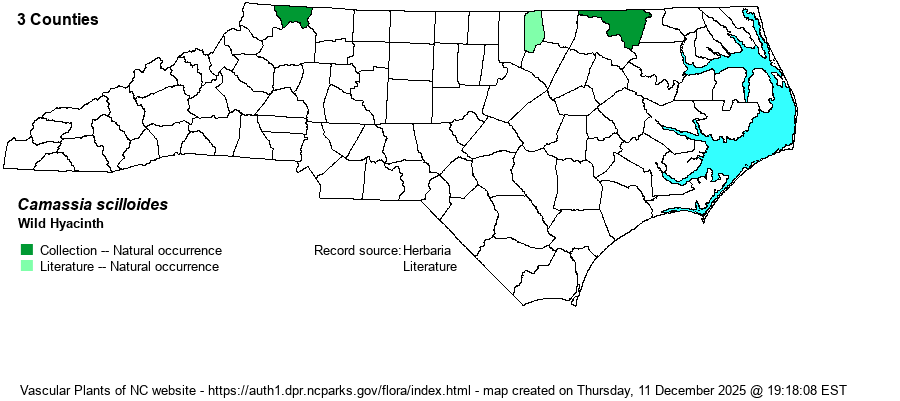| Author | (Rafinesque) Cory | |
| Distribution | Strictly in the northernmost portions of the Mountains, Piedmont, and western Coastal Plain. Known from just three counties. Photos on iNaturalist from Buncombe and Haywood counties probably refer to planted individuals; however, BONAP shows records for eastern TN not too far west of NC, and the species does range south to northern SC and northwestern GA.
The species is essentially one of the Mississippi and Ohio drainages. It ranges from western PA west to IA, and south to southern AL and central TX. There are only scattered records east of the Appalachians, essentially in NC and SC. In fact, there is a very large population in the York and Chester counties area of northern SC, in the well-known "Camassia Flats", which is odd considering there are no records from the southern or central portions of NC. | |
| Abundance | Extremely rare to very rare, being one of the rarest lily species in the state. In fact, when RAB (1968) was published, it was not known at all from the state; the first NC record came from Northampton County in 1979. It is a State Threatened species. | |
| Habitat | This is a species that requires high pH soils. It grows mainly on forested slopes or levees in rich alluvial soils, such as along or very close to the Roanoke River and the Tar River. The mountain site is in rich, moist soil very close to a small creek. The large SC population is mostly in a wet, poorly drained forested "flat" over high pH soil. |
| Phenology | Blooms from early April to mid-May, and fruits mostly in May. | |
| Identification | This is one of our most striking wildflowers when seen in a large colony, such as the stand along the Roanoke River, owing mostly to the soft blue flower color. The species has a basal clump of very narrow leaves, which grow to 1.5-2 feet long but less than 1 inch wide. The flowering stalk is about 1.5 feet tall, with the upper third (about 6 inches) being the fairly dense raceme of rather large and light blue flowers. Each flower has 6 narrow tepals, and the spread flower is about 1 inch across. As there are very few pale blue flowers among the lily species, as well as among spring-blooming wildflowers, this is a notable species that is unforgettable when seen in flower. Unfortunately, you will almost certainly not run across the species on your own, and you likely will need to be on a guided field trip to the Roanoke River site. The species can be tricky to identify if not in flower, as other species of monocots have basal clumps of long and narrow leaves. | |
| Taxonomic Comments | None
| |
| Other Common Name(s) | Atlantic Camas, Eastern Camas, Eastern Camas Lily | |
| State Rank | S1 | |
| Global Rank | G5 | |
| State Status | T | |
| US Status | | |
| USACE-agcp | FACW link |
| USACE-emp | FAC link |

